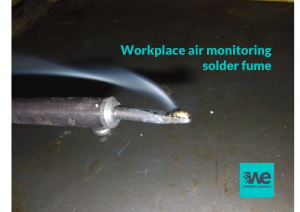Solder Fume exposure
Why should we be concerned about Solder Fume Exposure? it’s a question we get asked, in this article we’ll explain why, and how to monitor and control the risks around Solder Fume Exposure.
What is Soldering
Soldering is used to join metals, such as tin, iron, copper, silver and steel. Heat and a filler metal are used together. A filler metal is a metal that melts at a lower temperature than the metal itself and fills the join with the addition of a flux that prepares the surface for heating.
Risks of Soldering
Soldering is used to produce and assemble electronic circuit boards and join electrical circuits. Whilst the temperature involved is relatively low, it vapourises and a visible ‘plume’ of white fume is produced. It has the potential to be breathed in by workers carrying out the process. The solder flux usually contains colophony (this is when the flux is sourced from rosin – pine resin) and this generates rosin solder flux fume. This is harmful to health and is also a respiratory sensitiser, which means it has the potential to cause occupational asthma if the exposure is not controlled.
Occupational asthma
Occupational asthma means that a person’s airways are hypersensitive to that substance, meaning that even a tiny quantity of exposure can trigger symptoms. Initial ill health effects that may occur are coughing, bronchitis, headaches, dizziness, sneezing, eye watering and eye and nose and chest irritation.
The Control of Substances Hazardous to Health (Coshh) Regulations 2002 and other various guidance documents explain how to control exposure to hazardous substances such as soldering. In general, a good control solution is one that minimises the health risk, whilst reducing maintenance burdens, and being straightforward to use and maintain.
Workplace Exposure Limits
Rosin-based solder flux fume has a Workplace Exposure Limit (WEL) of 0.05mg/m³ (8hr TWA long term limit, current at 2017) to check exposure levels. During various stages of the process, personal exposure monitoring by means of an air monitoring survey should be considered to provide evidence of control, and information on where to focus the efforts, along with competent occupational hygiene advice. Improvements to improve workplace exposure need not be a financial burden, or be time consuming, ideas can often come from the workforce. It is important to note that any control measures need to be easy to use, keep clean, and maintain.

Aim to Control Exposure to Solder fume
Substitution of rosin-based solder flux should first be considered to minimise the risk to health. Consider if a less harmful joining method or product can be used. Segregation is a part of the Coshh hierarchy of control to be considered. Could the process be automated or enclosed, could the worker separated from the soldering. If soldering by hand, the soldering tool could be fitted with tip extraction as Local Exhaust Ventilation (LEV) to stop the solder fume being breathed in by the worker, and those working around them. A suitable work bench that effectively draws air down though it, to remove the fumes, could also be investigated as an option The use of an enclosing hood or moveable LEV capture hood are other alternatives.
Working practice and PPE are the last considerations to think about, and include procedures, keeping areas and tools clean, ensuring staff check filters on the LEV units, instructing workers to keep their face/head away from the plume of solder that is made.
Our approach
Get in touch with Workplace Exposure, either give us a call on 0800 689 4386, or fill in our enquiry form to discuss your monitoring or consultancy requirements.
We’ll then provide you with a no obligation proposal, we can often give an initial idea of fees whilst we discuss your needs.
Once you’ve accepted our proposal we can then schedule the work.
Following our site visit we’ll provide you with a comprehensive report giving you advice, recommendations and control measures where appropriate.
Implement the outcomes for compliance and a happier healthier workplace.
